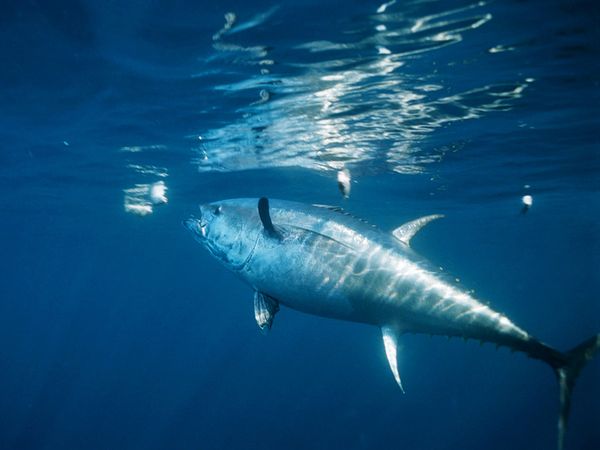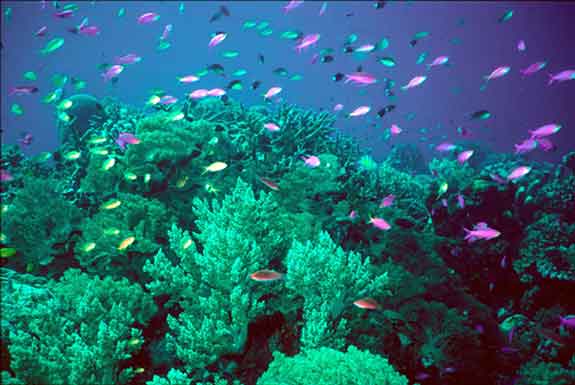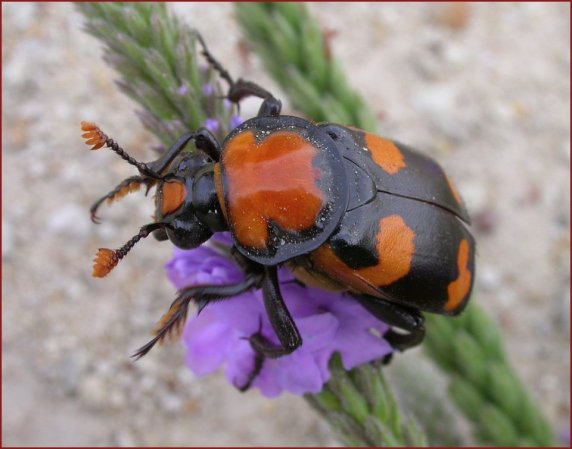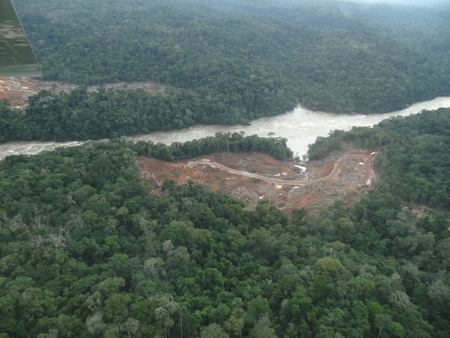
by Deep Green Resistance News Service | Sep 23, 2012 | Biodiversity & Habitat Destruction
By Gaia Vince / BBC News
Global fish stocks are exploited or depleted to such an extent that without urgent measures we may be the last generation to catch food from the oceans.
It has been some time since most humans lived as hunter-gatherers – with one important exception. Fish are the last wild animal that we hunt in large numbers. And yet, we may be the last generation to do so.
Entire species of marine life will never be seen in the Anthropocene (the Age of Man), let alone tasted, if we do not curb our insatiable voracity for fish. Last year, global fish consumption hit a record high of 17 kg (37 pounds) per person per year, even though global fish stocks have continued to decline. On average, people eat four times as much fish now than they did in 1950.
Around 85% of global fish stocks are over-exploited, depleted, fully exploited or in recovery from exploitation. Only this week, a report suggested there may be fewer than 100 cod over the age of 13 years in the North Sea between the United Kingdom and Scandinavia. It’s a worrying sign that we are losing fish old enough to create offspring that replenish populations.
Large areas of seabed in the Mediterranean and North Sea now resemble a desert – the seas have been expunged of fish using increasingly efficient methods such as bottom trawling. And now, these heavily subsidised industrial fleets are cleaning up tropical oceans too. One-quarter of the EU catch is now made outside European waters, much of it in previously rich West African seas, where each trawler can scoop up hundreds of thousands of kilos of fish in a day. All West African fisheries are now over-exploited, coastal fisheries have declined 50% in the past 30 years, according to the UN Food and Agriculture Organisation.
Catches in the tropics are expected to decline a further 40% by 2050, and yet some 400 million people in Africa and Southeast Asia rely on fish caught (mainly through artisanal fishing) to provide their protein and minerals. With climate change expected to impact agricultural production, people are going to rely more than ever on fish for their nutritional needs.
The policy of subsidising vast fishing fleets to catch ever-diminishing stocks is unsustainable. In Spain, for example, one in three fish landed is paid for by subsidy. Governments, concerned with keeping jobs alive in the fishing industry in the short-term, are essentially paying people to extinguish their own long-term job prospects – not to mention the effect on the next generation of fishermen. Artisanal fishing catches half the world’s fish, yet it provides 90% of the sector’s jobs.
Protect depletion
Clearly, industrialised countries are not about to return to traditional methods. However, the disastrous management of the industry needs to be reformed if we are to restore fisheries to a sustainable level. In the EU alone, restoring stocks would result in greater catches of an estimated 3.5 tonnes, worth £2.7 billion a year.
Rather than having a system in which the EU members each hustle for the biggest quotas – which are already set far beyond what is sustainable – fisheries experts suggest individual governments should set quotas based on stock levels in their surrounding waters. Fishermen should be given responsibility over the fish they hunt – they have a vested interest in seeing stocks improve, after all – and this could be in the form of individual tradable catch shares of the quotas. Such policies end the tragedy of the commons situation whereby everyone grabs as much as they can from the oceans before their rival nets the last fish, and it’s been used successfully in countries from Iceland to New Zealand to the US. Research shows that managing fisheries in this way means they are twice as likely to avoid collapse as open-access fisheries.
In severely depleted zones, the only way to restore stocks is by introducing protected reserves where all fishing is banned. In other areas, quota compliance needs to be properly monitored – fishing vessels could be licensed and fitted with tracking devices to ensure they don’t stray into illegal areas, spot-checks on fish could be carried out to ensure size and species, and fish could even be tagged, so that the authorities and consumers can ensure its sustainable source.
The other option is to take humanity’s usual method of dealing with food shortages, and move from hunter-gathering to farming.
Already, more than half of the fish we eat comes from farms – in China, it’s as high as 80% – but doing this on an industrial scale has its problems. Farms are stocked with wild fish, which must then be fed – larger fish like salmon and tuna eat as much as 20 times their weight in smaller fish like anchovies and herring. This has led to overfishing of these smaller fish, but if farmed fish are fed a vegetarian diet, they lack the prized omega-3 oils that make them nutritious, and they do not look or taste like the wild varieties. Scientists are working to create an artificial version of omega-3 – current synthetic omega-3 versions are derived from fish oils.
Fish farms are also highly polluting. They produce a slurry of toxic run-off – manure – which fertilises algae in the oceans, reducing the oxygen available to other species and creates dead zones. Scotland’s salmon-farming industry, for example, produces the same amount of nitrogen waste as the untreated sewage of 3.2 million people – over half the country’s population. As a result, there are campaigns to ban aquaculture from coastal areas.
Farmed fish are also breeding grounds for infection and parasites that kill off large proportions of fish – escapees then frequently infect wild populations. Farmers try to control infestations with antibiotics, but usually only succeed in creating a bigger problem of antibiotic resistance.
Read more from BBC News:

by Deep Green Resistance News Service | Sep 19, 2012 | Biodiversity & Habitat Destruction, Climate Change
By Inter-Press Service
Limiting climate change to two degrees C won’t save most coral reefs, according to new, state-of-the-art research.
About 70 percent of corals are projected to suffer from long-term degradation by 2030 with two degrees C of warming, the first comprehensive global survey reported Sunday in the journal Nature Climate Change.
The planet will get far hotter than two degrees C based on current commitments by countries to reduce their greenhouse gas emissions, mainly from burning oil, gas and coal. Humanity is on course to heat up the atmosphere an average of three and even four degrees C, according to the Climate Action Tracker, an international scientific monitor. Those temperature levels are what most scientists consider “catastrophic”.
Global temperatures have risen an average of about 0.8C so far and already melted much of the Arctic and generated costly extreme weather events around the planet. Keeping that global average increase below two degrees is only a matter of “political will” not technology, said Bill Hare, director of Climate Analytics, one of the partners in the Climate Action Tracker.
If humanity wants to keep at least half of the remaining coral reefs, then global temperatures cannot rise to 1.5C. “Limiting global warming to 2 C is unlikely to save most coral reefs,” the paper reports.
“We must realise what is at stake as global temperatures rise,” said co-author Malte Meinshausen of School of Earth Sciences at the University of Melbourne.
“Countries must be as ambitious as possible in their emission reductions to give corals a chance,” Meinshausen told IPS.
Coral reefs are considered by many to be one of the life-support systems essential for human survival. For more than 2.6 billion people, seafood is the main source of protein. Corals act as the nurseries and habitat for many fish species, and are vital for up to 33 percent of all ocean species, according to the World Conservation Union (IUCN).
Reefs also provide vital shoreline protection from storms. Without reefs, for example, Belize would suffer 240 million dollars in damage from storms, according to one estimate.
This study used the very latest climate models and applied them to growing science about the impacts of rising temperatures and acidification levels projected in the decades to come, said co-author Simon Donner, a marine biologist and climatologist at the University of British Columbia.
The increasing ocean acid conditions appear to be reducing coral’s thermal tolerance, Donner said in an interview. Tropical corals have a narrow water temperature range in which they thrive. When water temperature rises only two or three degrees, they “bleach” or turn white.
Corals can survive this, but if the heat stress persists long enough – weeks instead of days – the corals can die in great numbers, as they did in 1998 when 16 percent of the world’s tropical corals died.
Emissions of greenhouse gases are not only warming the oceans, they have also made them 30 percent more acidic. The oceans and the atmosphere are intimately connected. When CO2 is released into the atmosphere from burning fossil fuels, some of that extra CO2 combines with carbonate ions in seawater, forming carbonic acid. This level of change in ocean chemistry has not happened in millions of years and is beginning to dissolve reefs.
Some corals will undoubtedly survive and some will adapt to the new conditions, although the changes are far more rapid than anything corals have ever experienced, said Donner.
“The bottom line is that humanity will lose the services that corals have provided for thousands of years,” he said.
Even at 1.5 C degrees of warming, only about half corals are likely to survive, the study found. That adds scientific weight to the small island nations’ and other countries’ call for a global target of 1.5 C, Donner said.
Every nation in the world officially agreed to keep global temperature increase below two degrees C at a U.N. climate meeting in Cancun, Mexico in 2010. An alliance of small islands and African countries had lobbied for the global target of less than 1.5 C due to the damages they are expected to suffer if temperatures rise above that mark.
Emissions must begin to decline this decade for either target so it is pointless to debate these targets right now, says Meinshausen. Once emissions are in significant decline, then how fast and how deep those cuts will have relevance for the final target, he said.
“I fear we’re going to miss our only chance to peak emissions this decade,” he said.
Read more from Inter-Press Service: http://www.ipsnews.net/2012/09/deeper-co2-cuts-needed-to-save-corals/

by Deep Green Resistance News Service | Sep 10, 2012 | ANALYSIS, Biodiversity & Habitat Destruction, Climate Change
By Mongabay
Already facing an onslaught of threats from logging and conversion for agriculture, forests worldwide are increasingly impacted by the effects of climate change, including drought, heightened fire risk, and disease, putting the ecological services they afford in jeopardy, warns a new paper published in the journal Nature Climate Change.
The study, authored by William Anderegg of Carnegie Institution for Science at Stanford University and Jeffrey Kane and Leander Anderegg of Northern Arizona University, reviews dozens of scientific papers dealing with the ecological impacts of climate change. They find widespread cases of forest die-off from drought and elevated temperatures, which can increase the incidence of fire and pest infestations like pine beetles. These effects have the potential to trigger transitions to other ecosystems, including scrubland and savanna. But the impacts vary from forest to forest and the authors say more research is needed to fully understand the effects of climate change on forest ecosystems.
However it is not only forests that are affected by climate change — they themselves impact climate. Forests store 45 percent of the carbon found in terrestrial ecosystems and sequester as much as 25 percent of annual carbon emissions from human activities, helping mitigate a key driver of climate change. Yet they also raise local temperate by absorbing sunlight. Clearing forests in polar regions has the paradoxical effect of increasing the reflectivity of Earth’s surface, reducing local temperatures. Yet clear-cutting of forests in the tropics accounts for 8-15 percent of anthropogenic greenhouse gas emissions.
The authors say that the research gaps make it difficult to forecast the economic and ecological impacts of climate change on forests, which cover cover some 42 million square kilometers or 30 percent of Earth’s land surface and underpin hundreds of billions to trillions of dollars a year in economic activity.
“The varied nature of the consequences of forest mortality means that we need a multidisciplinary approach going forward, including ecologists, biogeochemists, hydrologists, economists, social scientists, and climate scientists,” said William Anderegg in a statement. “A better understanding of forest die-off in response to climate change can inform forest management, business decisions, and policy.”
From Mongabay: “Climate change causing forest die-off globally”
Photo by Federico Bottos on Unsplash
by Deep Green Resistance News Service | Sep 7, 2012 | Agriculture, Biodiversity & Habitat Destruction
By Agence France-Presse
A large palm oil plantation project in development in Cameroon since 2010 will put livelihoods and ecosystems in peril if allowed to continue, a US-based think-tank warned Wednesday.
“With the loss of livelihoods by thousands of Cameroonians on the line and critical and unique ecosystems in peril, this project must be stopped,” the Oakland Institute said in a report Wednesday.
Authoured in collaboration with Greenpeace International, the report said the project from SG Sustainable Oils Cameroon (SGSOC) was a case of massive deforestation disguised as a sustainable development project.
In 2009, Cameroon granted SGSOC, a subsidiary of US firm Herakles Farms, over 73,000 hectares (180,000 acres) of land in the country’s southwest to develop the plantation and refinery through a 99-year land lease.
But much of the project area is in a “biodiversity hotspot” that “serves as a vital corridor between five different protected areas,” the institute said.
It added that many locals fear the plantation would “restrict their access to lands held by their ancestors for generations” or that they would “lose land for farming as well as access to critical natural resources and forest products.”
In April, “11 of the world’s top scientists issued an open letter urging the Cameroonian government to stop the project that they say will threaten some of Africa’s most important protected areas,” the think-tank said.
But Bruce Wrobel, CEO of Herakles Farms, told the institute that “our project, should it proceed, will be a big project with big impacts — environmentally and socially.”
“I couldn’t be more convinced that this will be an amazingly positive story for the people within our impact area,” he was quoted saying in the report.
From Agence France-Presse:

by Deep Green Resistance News Service | Sep 1, 2012 | Biodiversity & Habitat Destruction
By Zoological Society of London
One fifth of the world’s invertebrates may be heading for extinction according to ‘Spineless’, a report published today (Friday 31st) by the Zoological Society of London (ZSL), in conjunction with IUCN and the IUCN Species Survival Commission.
Digging up earthworms, chasing butterflies and collecting clam shells could become a thing of the past if enough isn’t done to protect invertebrates. And if they disappear, humans could soon follow. These critters form the basis of many of the essential benefits that nature provides; earthworms recycle waste nutrients, coral reefs support a myriad of life forms and bees help pollinate crops.
More than 12,000 invertebrates from the IUCN Red List of Threatened Species were reviewed by conservation scientists who discovered freshwater species to be under the highest risk of extinction, followed closely by terrestrial and marine invertebrates. The findings from this initial group of global, regional and national assessments provide important insight into the overall status of invertebrates. Together they indicate that the threat status of invertebrates is likely very similar to that of vertebrates and plants.
Invertebrates are at risk from a variety of threats. Molluscs such as thick shelled river mussels suffer from pollution from agricultural sources and dam construction, which affects the quality of the water they live in. Crayfish such as the noble crayfish, are at risk from the impact of invasive species and diseases. What starts off as a local decline could lead to a global extinction, and recognising the growing pressures on invertebrates is critical to informing more effective conservation.
Dr. Ben Collen, head of the Indicators and Assessments unit at ZSL says: “Invertebrates constitute almost 80 per cent of the world’s species, and a staggering one in five species could be at risk of extinction. While the cost of saving them will be expensive, the cost of ignorance to their plight appears to be even greater”.
The highest risk of extinction tends to be associated with species that are less mobile and are only found in small geographical areas. For example, vertebrate amphibians and invertebrate freshwater molluscs both face high levels of threat – around one third of species. In contrast, invertebrate species which are more mobile like dragonflies and butterflies face a similar threat to that of birds, and around one tenth of species are at risk.
ZSL’s Director of Conservation, Professor Jonathan Baillie added: “We knew that roughly one fifth of vertebrates and plants were threatened with extinction, but it was not clear if this was representative of the small spineless creatures that make up the majority of life on the planet. The initial findings in this report indicate that 20% of all species may be threatened. This is particularly concerning as we are dependent on these spineless creatures for our very survival.”
Read more from Zoological Society of London: http://www.zsl.org/conservation/news/invertebrates-on-the-brink,993,NS.html

by Deep Green Resistance News Service | Aug 26, 2012 | Biodiversity & Habitat Destruction, Colonialism & Conquest, Indigenous Autonomy, Lobbying
By Fabiola Ortiz / Inter Press Service
The Sete Quedas or “seven waterfalls” on the Teles Pires River, which runs through the Amazon rainforest states of Mato Grosso and Pará in central Brazil, are a spiritual oasis venerated by several indigenous groups.
But the 20-metre-high rocky falls are to be covered by a reservoir created by a hydroelectric dam that is to flood an area of 95 square km.
“It’s a sacred area, our creator and mother. And the ‘pajé’ (shaman) says it is where the fish lay their eggs,” João Kayabi, 52, told IPS by phone from the area. He is the chief of Kururuzinho village, home to 106 members of the Kayabi community, who speak a Tupí-Guaraní language.
For the Kayabi, the area around Sete Quedas must be left untouched, because it is the dwelling of a god who is responsible for the natural balance.
“It will be left underwater, and will only be a memory. We are trying to keep that from happening,” Kayabi said.
Sete Quedas is also sacred to two other indigenous communities: the Apiaká and the Mundurukú. For the latter, the falls are “the mother of fish” and the dwelling-place of their ancestors.
“The Mundurukú say the river is going to dry up, there will be a shortage of food, and the fish will vanish. I hope that isn’t so,” Kayabi said.
Studies on the biodiversity in that stretch of the river, carried out by Brazil’s Energy Research Company (EPE), which conducts research for the Ministry of Mines and Energy, have identified nearly 700 plant species and more than 200 species of fish, such as the spotted sorubim (Pseudoplatystoma corruscans) catfish, the common dolphinfish (Coryphaena hippurus), and the jau (Zungaro zungaro) catfish.
The Teles Pires has the reputation of being one of the world’s best rivers for fishing.
In the indigenous territory where João Kayabi’s village is located, nearly 300 people make a living from hunting, fishing and harvesting fruit.
“Up to now, our land has provided for us sufficiently. But we are concerned about what will happen in the future, and whether food will be scarce,” said the chief, a father of seven. “I’m worried about my children; I don’t know what will become of their lives.”
The Teles Pires plant will have a generating capacity of 1,820 MW. But the Companhia Hidrelétrica Teles Pires, the company that was granted the concession for building the dam, is fighting a judicial battle to be able to finish construction.
The project collides with the beliefs, customs and traditions of the Kayabi, Mundurukú and Apiaká Indians (a combined total of 12,000 people), said indigenous rights lawyer Juliana de Paula Batista, who advises native organisations in Brazil’s southwest Amazon region.
The case has been winding its way through the courts. In early August, a regional federal court ordered suspension of construction of the dam. But the attorney general’s office and Brazil’s environmental protection agency IBAMA appealed, and the suspension was lifted on Aug. 14.
“The natural resources that are indispensable for indigenous people to sustain their lifestyle and culture are being plundered,” Batista told IPS.
Early this year, the office of the public prosecutor brought a civil lawsuit to revoke the environmental license granted by IBAMA in August 2011 and bring construction to an immediate halt.
According to Batista, the environmental licensing process is flawed. “At no time has the magnitude of the impact on indigenous lands been fully understood.”
“The dam endangers fish stocks, the sacred site, water quality, rare and endemic species, vegetation in general, and hunting,” the lawyer said.
Although the tribes will not have to be relocated, they are afraid to remain in their villages “because in case of accidents, such as a break in the dam, the water would carry them away,” Batista said.
The Kayabi villages are only 50 km from the dam.
“There is no solution when it’s a government plan, we have no way to fight this,” Kayabi said. “The only way is to seek support and guidance. The dam will be built, and we are the ones who will be hurt by it, we could lose our rights.”
One of the irregularities noted by the office of the public prosecutor was the company’s failure to consult with the affected indigenous communities prior to the start of construction, as required by law. In March, work on the dam had already been suspended in response to the prosecutors’ request.
Read more from Inter Press Service: http://www.ipsnews.net/2012/08/hydropower-dam-to-flood-sacred-amazon-indigenous-site/





